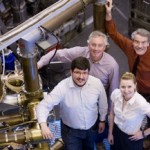Fusion Power Plants
 Fusion power is the power generated by nuclear fusion processes. In fusion reactions two light atomic nuclei fuse together to form a heavier nucleus (in contrast with fission power which breaks up a heavier nucleus to release power). In doing so they release a comparatively large amount of energy arising from the binding energy due to the strong nuclear force which is manifested as an increase in temperature of the reactants. Fusion power is a primary area of research in plasma physics. Nuclear fusion is a seemingly ideal energy source: carbon-free, fuel derived largely from seawater, no risk of runaway reactors and minimal waste issues. With the world’s energy supply chain facing intense environmental, economic and political pressures, fusion’s appeal is growing and international collaboration is accelerating. The MIT Department of Nuclear Science and Engineering’s (NSE) long-standing fusion program is extending its leadership role in advancing the technology toward practical use in power plant design.
Fusion power is the power generated by nuclear fusion processes. In fusion reactions two light atomic nuclei fuse together to form a heavier nucleus (in contrast with fission power which breaks up a heavier nucleus to release power). In doing so they release a comparatively large amount of energy arising from the binding energy due to the strong nuclear force which is manifested as an increase in temperature of the reactants. Fusion power is a primary area of research in plasma physics. Nuclear fusion is a seemingly ideal energy source: carbon-free, fuel derived largely from seawater, no risk of runaway reactors and minimal waste issues. With the world’s energy supply chain facing intense environmental, economic and political pressures, fusion’s appeal is growing and international collaboration is accelerating. The MIT Department of Nuclear Science and Engineering’s (NSE) long-standing fusion program is extending its leadership role in advancing the technology toward practical use in power plant design.NSE’s fusion team is beginning a strategic pivot into the next stage of development, with a focus on interdisciplinary knowledge needed for the creation of functioning power plants.
“We’re basically making energy by creating a star,” explains NSE Professor Whyte. “For power generation, the star has to turn on, and stay on for a year at a time, and we need a way to extract the energy it creates.”
The next stage, Whyte explains, will require an evolution beyond the traditional focus on plasma physics, and towards practical power-plant issues that arise out of the need to maintain a continuous, self-sustaining burning plasma. This includes developing a better understanding of how materials behave under intense neutron and plasma bombardment.
Neutron bombardment creates big challenges, displacing every single atom within exposed reactor construction material 20 times in a year. Moreover, surface atoms would be displaced by plasma particles about a billion times annually. “The environment is constantly making and remaking the material,” says Whyte. “Amazingly, we think we can make this work, by developing an understanding not just of the plasma and the materials, but of their interaction. We have the leading effort here in that area.”
Fusion powered electricity generation was initially believed to be readily achievable, as fission power had been. However, the extreme requirements for continuous reactions and plasma containment led to generation projections being extended by several decades. In 2010, more than 60 years after the first attempts, commercial power production is still believed to be unlikely before 2050 by many experts.
You can return to the main Market News page, or press the Back button on your browser.

